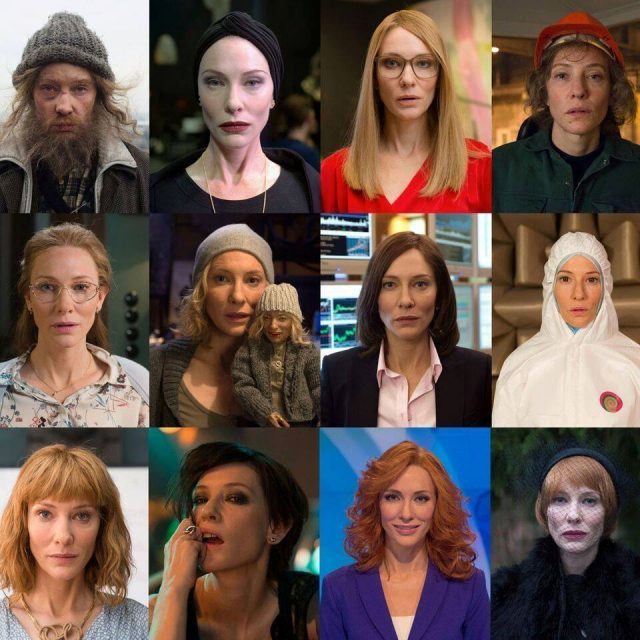
Cate Blanchett plays thirteen roles in twelve scenarios in Julian Rosefeldt’s Manifesto
MANIFESTO (Julian Rosefeldt, 2017)
Film Forum
209 West Houston St. between Sixth Ave. & Varick St.
Opens Wednesday, May 10
212-727-8110
filmforum.org
www.facebook.com
 Julian Rosefeldt’s Manifesto previously manifested as a captivating thirteen-channel installation in the Park Avenue Armory’s massive Wade Thompson Drill Hall, where visitors could walk among thirteen enormous screens, experiencing the work in whatever order they preferred, watching all 130 minutes or cherry picking individual scenes. Each screen (except for the prologue) showed a specific ten-and-a-half-minute scenario, running concurrently, in which Oscar-winning actress Cate Blanchett played a different character (in one she played two), her dialogue consisting almost exclusively of quotes from more than fifty manifestos by such artists and thinkers as Dziga Vertov, Claes Oldenburg, André Breton, Yvonne Rainer, Lars von Trier, Adrian Piper, Wassily Kandinsky, Guillaume Apollinaire, Lucio Fontana, Werner Herzog, and Marx and Engels. The stunning visuals, featuring spectacular indoor and outdoor architecture gorgeously photographed by Christoph Krauss, distracted positively from much of the theoretical mush, formal language that is not easy to turn into a film. Now writer-director Rosefeldt and editor Bobby Good have chopped Manifesto into a disappointing ninety-four-minute movie shown on a single screen, cutting back and forth among the scenarios, sacrificing the meditative rhythm of the long, individual scenes, each of which began with a lovely, peaceful establishing shot, and unfortunately highlighting snippets of pompous intellectual meanderings, eliminating the undercurrent of humor that made the installation worth watching in full.
Julian Rosefeldt’s Manifesto previously manifested as a captivating thirteen-channel installation in the Park Avenue Armory’s massive Wade Thompson Drill Hall, where visitors could walk among thirteen enormous screens, experiencing the work in whatever order they preferred, watching all 130 minutes or cherry picking individual scenes. Each screen (except for the prologue) showed a specific ten-and-a-half-minute scenario, running concurrently, in which Oscar-winning actress Cate Blanchett played a different character (in one she played two), her dialogue consisting almost exclusively of quotes from more than fifty manifestos by such artists and thinkers as Dziga Vertov, Claes Oldenburg, André Breton, Yvonne Rainer, Lars von Trier, Adrian Piper, Wassily Kandinsky, Guillaume Apollinaire, Lucio Fontana, Werner Herzog, and Marx and Engels. The stunning visuals, featuring spectacular indoor and outdoor architecture gorgeously photographed by Christoph Krauss, distracted positively from much of the theoretical mush, formal language that is not easy to turn into a film. Now writer-director Rosefeldt and editor Bobby Good have chopped Manifesto into a disappointing ninety-four-minute movie shown on a single screen, cutting back and forth among the scenarios, sacrificing the meditative rhythm of the long, individual scenes, each of which began with a lovely, peaceful establishing shot, and unfortunately highlighting snippets of pompous intellectual meanderings, eliminating the undercurrent of humor that made the installation worth watching in full.
Even Blanchett’s tour-de-force performance, playing such characters as a homeless man (Situationism), a funeral speaker (Dadaism), a financial broker (Futurism), a choreographer (Fluxus / Merz / Performance), a news reader and a reporter (Conceptual Art / Minimalism), and a teacher (Film), gets lost in the transition and now feels like more of a gimmick. In addition, in the installation, about two-thirds of the way through each scene all the characters face the camera in unison and spout different philosophical musings in a robotic monotone, creating a choral cacophony that resounded through the cavernous space, dominated by giant close-ups of Blanchett everywhere; nothing like that happens in the shortened film. Kudos still go out to costume designer Bina Daigeler, makeup magician Morag Ross, hair stylist Massimo Gattabrusi, and production designer Erwin Prib, but Rosefeldt (Trilogy of Failure, Deep Gold, The Ship of Fools) and Good have done a disservice to what was a grand work of art that itself was a grand statement about the critical importance of art. “Originality is nonexistent,” Blanchett says as a teacher, quoting Jim Jarmusch. “I am writing a manifesto because I have nothing to say,” she narrates in the prologue, quoting Philippe Soupault. The original Manifesto installation had plenty to say; the single-screen theatrical version, however, does not.